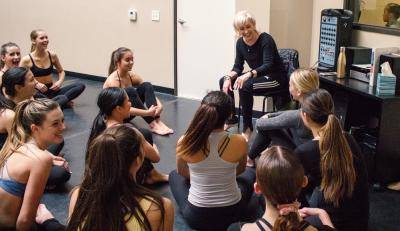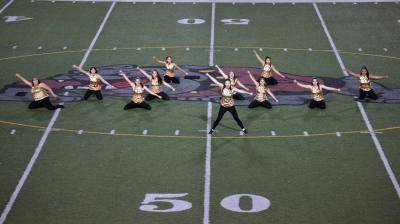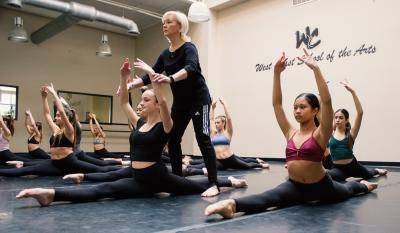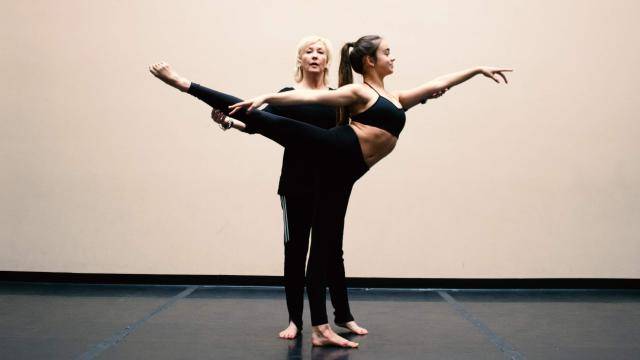Dance is a particularly popular extracurricular for young children, and many pursue the activity regularly, finding themselves enrolled in their local dance studio from toddlerhood all the way up to teenagedom. However, once a student reaches high school, something often changes with their dance training. Many students will become more serious and invested, pursuing dance competitions like YAGP, if they weren’t already, while others will quit in favor of the new and different activities a high school has to offer. Finally, there is a third path: the child, still interested in dance, leaves their home studio in favor of participation in their high school dance team.
Many studios begin to see gradual attrition of their teen student body. Though many teens remain dedicated to their studio’s dance education throughout high school, it is common for studios to have a somewhat pyramidal structure when it comes to the number of students. The classes with the most kids are usually in the younger age ranges, while the classes with smaller numbers tend to be the older, higher ranking, teenagers. Now, this can result from multiple circumstances, including time commitments, personal interests or goals, or a family’s economic and financial priorities. To explore this further, I sat down with Paula Kessinger, the owner of West Coast School of the Arts, and Myra Joy Veluz, the dance team coach at West Covina High School to discuss the ongoing teen trend of studio to team migration.
So why dance team?
According to Kessinger and her over forty years of dance teaching experience, this is not a new phenomenon. When a child hits high school, it often involves a complete change in environments. Surrounded by new teachers and classmates, many kids often seek out activities that pique their interest in an attempt to find a new friend group and place to fit in. So it makes sense that children with dance experience often see their high school dance team as a fun group activity to join that falls in line with their general interests. As Veluz notes, “My students love that it (dance team) gives them dance opportunities at school... it’s a great way for them to feel connected to their school.” Kessinger echoes Veluz’s sentiments, acknowledging that dance teams can frequently offer “more team bonding experiences.”

Kessinger is also sympathetic to the obvious fact that high school students often see their academic workload exponentially increase as the demands on their dance training rise: “some kids just can’t juggle it all.” Even those students who don’t have a packed dance schedule might find the multitasking necessary to balance their newfound schoolwork and activities paired with their former dance schedule all too much to bear. Parents might preemptively pull their kids out of a dance studio setting to protect their kids’ academic aspirations, reasoning that the dance team will be a suitable replacement for their child’s artistic needs.
Both Veluz and Kessinger agree that finances play a huge role in a family’s decision to walk away from dance studio training. It can be prohibitively expensive on its own, and the price tag for participation in a high school’s dance team can also run surprisingly high. Kessinger highlights the uniform fees, camp fees, and other miscellaneous costs that can set a family back as much as five thousand dollars. It should come as no shock then that involvement in both a studio and a team might be financially impossible for many families. Veluz cites cost as one of the top reasons that students on her team don’t partake in outside studio classes. “Socio-economically, they aren’t able to participate in both a studio and their dance team. It’s one hundred and fifty thousand percent driven by financial roadblocks in their (the family’s) way.”
So if the families are unable to participate in both due to understandable time and financial constraints, what makes the kids pick their dance team over the dance studio? Kessinger highlights the individual’s dance goals and aspirations as a possible answer. Thousands and thousands of children dance, but only a small percentage of those go on to a dance major in college and/or a professional career in dance. Teens who eagerly choose dance teams over studio training may not be interested in dance as anything beyond a valuable childhood experience. “If you’re going to be a dance major in college, you’re going to want to stay at a dance studio until you graduate...I don’t think college dance programs look at dance team participation and studio training in the same way.”
For a kid who loves to dance but doesn’t want it as a career, the constraints set upon them by their economic situation coupled with the allure of finding their place at their new school through team membership will certainly drive their ultimate decision.
Dance Team vs. Dance Studio
Even though both offer exposure to and education around the art form of dance, the experiences provided by a dance team compared to a dance studio are vastly different. As previously mentioned, a dance education provided under the auspices of a studio might be more beneficial for the more serious or dedicated dance student. Veluz, who also has experience teaching at a dance studio, acknowledges that studios are able to supply more individualized and specialized training, and Kessinger agrees, noting that a studio can provide “better, consecutive training.” It should be obvious that a place that has been a home for training from early youth to young adulthood should certainly offer a clear progression through and understanding of various dance techniques that a four year high school team cannot match.
However, as Kessinger aptly notes, the social aspects of the two activities are where dance teams really shine. “Dance teams offer more bonding and social experiences... as well as team building and bonding with other schools. You don’t get that in competitive studios as much. High school dance teams have really honed in on that with programs like big sister/little sister and by involving the parents more.” The daily structure of dance studio life as well as the large age range that is served makes that kind of intense and close team building more difficult to execute. With a dance team, it’s the same group of kids day in and day out, all in the same age range. At a dance studio, friends might take different classes and age groups might be more fluid. A dance team creates the same kind of insular environment that a sports team does, and this social connection is not the focus at a strong dance studio. Veluz fondly opines on her students’ experience, stating that “their hard work and daily bonding with one another has created a level of camaraderie that they will remember long after high school.”

This is not to say that incredibly close bonds and friendships cannot be established at the studio. Some of my deepest friendships are with dancers I grew up next to at the barre, but the whole cohesive “team” experience is hard to replicate outside of a team-like structure. Teens, especially, are driven by social interactions among peers, so it should come as no surprise that a young teen, not too serious about dance as a career, would choose a dance team over a dance studio.
If a studio is suffering from heavy teen student losses year over year, Kessinger suggests that studios attempt to work with the local dance teams in the area rather than against them. “Studio owners have to be more flexible...it is difficult for the dancer to do both!” Kessinger uses an intelligent workaround for her studio’s dance company by refusing to compete earlier than April. By delaying her dance competition schedule, she avoids scheduling conflicts with the local dance teams and her students feel free to participate in both if they so choose. She also allows for more flexibility in attendance earlier in the year, only enforcing a strict attendance policy as time grows closer to her group’s competition season. Finally, she advises that studio owners should remain sensitive to the financial constraints a family might have and employ more team building and family-oriented activities within the studio.

Which is better?
There isn’t a better choice, only a choice that is better suited for each individual child and family. Both teams and studios serve and meet different needs within the community, and both assist in exposing children to and fostering a lifelong love of the arts. What’s important in this country is not that we have millions of highly trained professionals, but that we have a population who sees the value in participating in and supporting artistic endeavors. For far too long, the focus and funding in American education have drifted purely towards STEM, and the arts have been left on the chopping block. Veluz points out that each child’s dance team experience is going to vary depending on the school they attend and the district they are located in, and her words ring true for anyone involved in artistic endeavors. “The financial and political environment in the school is going to determine the level of success in dance for those students... If you have the budget to support a successful program, then it’s going to flourish and do really well. Where I am (West Covina), it’s very obvious that the community loves and supports the arts. They put the money into it. If there’s no funding, it’s never going to work.” Clearly, not all children will even have the option to pick between a dance studio and a dance team. Any avenue we have to educate children in the arts should be fostered, celebrated, and uplifted.
Paula Kessinger is the owner of West Coast School of the Arts in Costa Mesa, CA. With over forty years of teaching experience, both she and her studio have earned a prestigious reputation for excellence in dance education. She holds a degree in Theatre Arts and has performed as a dancer, actress, and ice skater on many stages for many years. Her dancers have gone on to Broadway and Hollywood, with many earning dance degrees from distinguished schools like Juilliard and USC. Her choreography has garnered awards from all over the globe and she has choreographed for top figure skaters and members of the United States Gymnastics Team.
Myra Joy Veluz is the dance team coach at West Covina High School in West Covina, CA. She holds an MFA in Dance from the University of Arizona and has lectured at Scripps College and Harvard University among others. She dances professionally in Los Angeles and is currently signed with Blue13 Dance Company. Additionally, she holds the UCLArts Social and Emotional Certificate to aid her work with children as well as Spin, Barre, and Fletcher Pilates Mat License Certifications.




